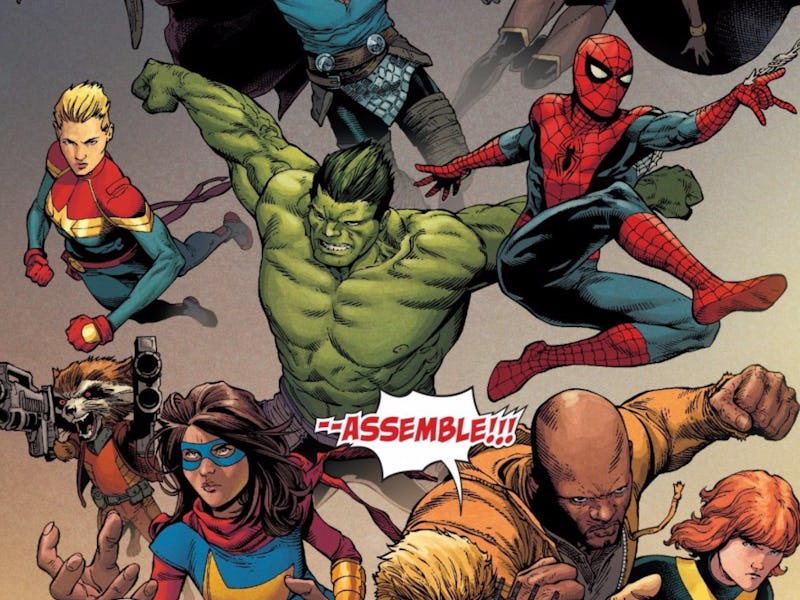This Is the Worst Panel in All of Superhero Comics
Assembling so much its lost all meaning.

Marvel’s controversial Secret Empire series mercifully came to an end on Wednesday with a final issue that finally brought down the evil, Hydra-aligned Captain America. The series, which drew criticism for turning an iconic symbol of American values into a fascist with overt Nazi connections, was offensive to many readers, yes, but it was also offensively boring. Many of the dramatic beats were delivered with the dramatic depth of an illustrated Wikipedia article. Nowhere was this more prevalent than in the final issue, which features a page that I’ve come to realize is actually one of the worst tropes in superhero comics.
Let’s call it “the assemble shot.”
In the Secret Empire finale, HydraCap, having harnessed the power of the almost-complete Cosmic Cube, attempts to get the remaining heroes to surrender for good without a fight. Because he’s evil and killed Black Widow a few issues earlier, the good guys reject this offer and heroically charge into battle.
Look at all these marketable heroes.
Since HydraCap possesses a universe-altering weapon, he trounces them just two pages later, but it’s not like the fight would’ve been anything special. The assemble shot is emblematic of the shortcuts and unearned grandeur that many event comic series fall prey to — or deploy, if you’re feeling cynical. It’s not the artist’s fault, it’s a failure of storytelling that they’re dutifully illustrating to the best of their abilities. Here’s how it works.
First, you get an assortment of your most marketable characters in one panel. For Marvel, this is a few heroes from popular or upcoming MCU films, some token X-Men, and the hot comic-only character of the moment. It’s a chance for the comic company to establish which characters are popular or should be popular, so if the specific characters assembling seems like a strangely specific assortment, that’s probably why (what are you doing there, Rocket Racoon?).
The next step is handwaving away the actual fighting. There’s a trope known as “conservation of ninjustu” which states that a group of 20 ninja goons will be super easy for the heroes to defeat, but one ninja will be a real threat. That’s just how this type of storytelling works, and it goes both ways. Luke Cage, the Hulk, and Spider-Man can all carry their own stories and fight their own battles, but together, the impact is lessened.
This is made worse by the way that superhero comics typically depict fight scenes. They’re rarely the focus of an entire issue, and usually boil down to a series of flashy moments. In Japanese shonen manga, though, a single fight can take several issues to finish. Individual punches, kicks, and moves all matter, and we see the strategy behind a victory or defeat. The manga style isn’t inherently better or worse than the Western superhero style, and indeed there are major structural differences in the way the two mediums come out. Manga are typically released weekly, aren’t colored, and the people who illustrate them are infamously overworked.
But, the way superhero comics traditionally illustrate fight scenes can make them easy to gloss over if the story behind them isn’t standing up on its own. The assemble shot gathers characters and hypes the audience up for an epic battle, but it almost never delivers. Often, the next page is a smattering of images of Iron Man punching Doctor Doom while Green Goblin get the best of Spider-Man, but none of it has any weight. These individual heroes that we love become interchangeable bit players.
Fight scenes shouldn’t be the end-all be all of a story. One of the reasons why Western comics don’t often go blow-by-blow is because empty action can be meaningless, and Marvel and DC comics try to tell a different, larger type of story. The assemble shot tries to have it both ways, in that it’s a storytelling shortcut that lets a comic tease an incredible, epic battle without devoting any real time to showing it or making it feel real. As a result, it’s insignificant. Floating captions, which often don’t offer anything more than a vaguely omniscient platitude like “we all fought,” give the resulting action all the excitement of a montage delivered via PowerPoint.
It doesn’t help that this happens All. The. Time. DC’s is guilty of this too, but here are a couple more examples from my Marvel library that I didn’t have to look that hard for.
Here’s an assemble shot from Secret Invasion:
The individual actions of these characters all matter, clearly.
Here’s one from Fear Itself, which at least had some cool new costumes to show off:
What is Black Widow's spine doing and also how is Hawkeye floating?
And here’s one from Monsters Unleashed, which really serves no other purpose than to say “hey, your favs are here”:
Oh, *that's* Spider-Man!
Event comic series bring heroes together so they can fight against evil despite impossible odds. Just assembling isn’t enough to make it feel like those high odds really matter, or that the gathering of good guys actually has any real strength or dramatic impact. The assembl shot is a really good opportunity for an artist to draw a bunch of different superheroes looking cool, but a tired and bad way to tell a story.
Secret Empire #10 cost me $5 for roughly 35 pages of story. Devoting an entire page to familiar heroes doing a familiar, unexciting thing is essentially filler.